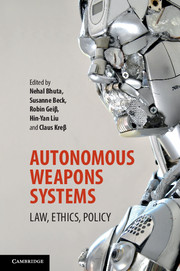Book contents
- Frontmatter
- Contents
- List of contributors
- Acknowledgements
- PART I Introduction
- PART II Meanings of autonomy and human cognition under automation
- PART III Autonomous weapons systems and human dignity
- PART IV Risk, transparency and legal compliance in the regulation of autonomous weapons systems
- 7 Judgment, liability and the risks of riskless warfare
- 8 Autonomous weapons systems and transparency: towards an international dialogue
- 9 A human touch: autonomous weapons, DoD Directive 3000.09 and the interpretation of ‘appropriate levels of human judgment over the use of force’
- 10 Autonomous weapons systems: managing the inevitability of ‘taking the man out of the loop’
- PART V New frameworks for collective responsibility
- PART VI New frameworks for individual responsibility
- PART VII Conclusion
- Index
9 - A human touch: autonomous weapons, DoD Directive 3000.09 and the interpretation of ‘appropriate levels of human judgment over the use of force’
from PART IV - Risk, transparency and legal compliance in the regulation of autonomous weapons systems
Published online by Cambridge University Press: 05 August 2016
- Frontmatter
- Contents
- List of contributors
- Acknowledgements
- PART I Introduction
- PART II Meanings of autonomy and human cognition under automation
- PART III Autonomous weapons systems and human dignity
- PART IV Risk, transparency and legal compliance in the regulation of autonomous weapons systems
- 7 Judgment, liability and the risks of riskless warfare
- 8 Autonomous weapons systems and transparency: towards an international dialogue
- 9 A human touch: autonomous weapons, DoD Directive 3000.09 and the interpretation of ‘appropriate levels of human judgment over the use of force’
- 10 Autonomous weapons systems: managing the inevitability of ‘taking the man out of the loop’
- PART V New frameworks for collective responsibility
- PART VI New frameworks for individual responsibility
- PART VII Conclusion
- Index
Summary
Introduction
This chapter addresses the legal, policy and military context of the drafting of ‘Autonomy in weapon systems’, the United States Department of Defense (DoD) Policy Directive 3000.09. More specifically, the author describes the development and interpretation of Directive 3000.09's requirement that autonomous weapons systems (AWS) be designed to allow commanders and operators to exercise ‘appropriate levels of human judgment over the use of force’. The chapter compares the Directive's standard with another conceptual vision for the development of autonomous functions and systems known as ‘coactive design’ or ‘human–machine interdependence’. Finally, the author argues that the increasing speed of autonomous technology – and the concomitant pressures to advance the related values of military necessity and advantage – eventually will cause the Directive's standard of ‘appropriate levels of human judgment over the use of force’ to be ineffective and irrelevant.
Directive 3000.09
The US government has begun to develop formal – albeit somewhat vague – policies concerning the development and use of semi-autonomous and autonomous weapons. In DoD Directive 3000.09, Ashton B. Carter, deputy secretary of defense for policy, defines ‘autonomous weapon system’ as a ‘weapon system that, once activated, can select and engage targets without further intervention by a human operator’. The drafters of the Directive defined ‘autonomous weapon systems’ as those that select and engage targets because the drafters wanted to focus on the most critical aspect of autonomy – the function of ‘lethality’ – where both human judgment and the law of armed conflict (currently) apply. This chapter adopts this definition of autonomous systems for the purposes of the discussion.
The Directive defines ‘semi-autonomous weapon system’ as a ‘weapon system that, once activated, is intended to only engage individual targets or specific target groups that have been selected by a human operator’. Progressively, the categorization of ‘semi-autonomous’ versus ‘autonomous’ is becoming a distinction without a difference as the line between the two becomes more difficult to discern. For example, the US military's new ‘long range anti-ship missile’ – a weapon the United States contends is semi-autonomous – can fly hundreds of miles after release by an aeroplane and identify and destroy a target without human oversight.
- Type
- Chapter
- Information
- Autonomous Weapons SystemsLaw, Ethics, Policy, pp. 185 - 208Publisher: Cambridge University PressPrint publication year: 2016
- 2
- Cited by



